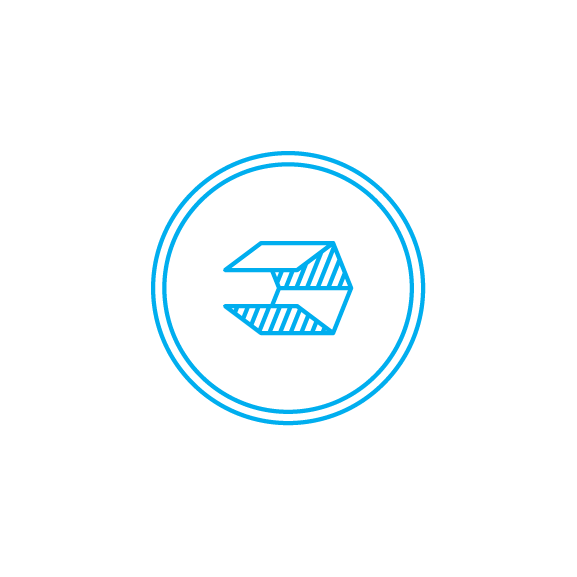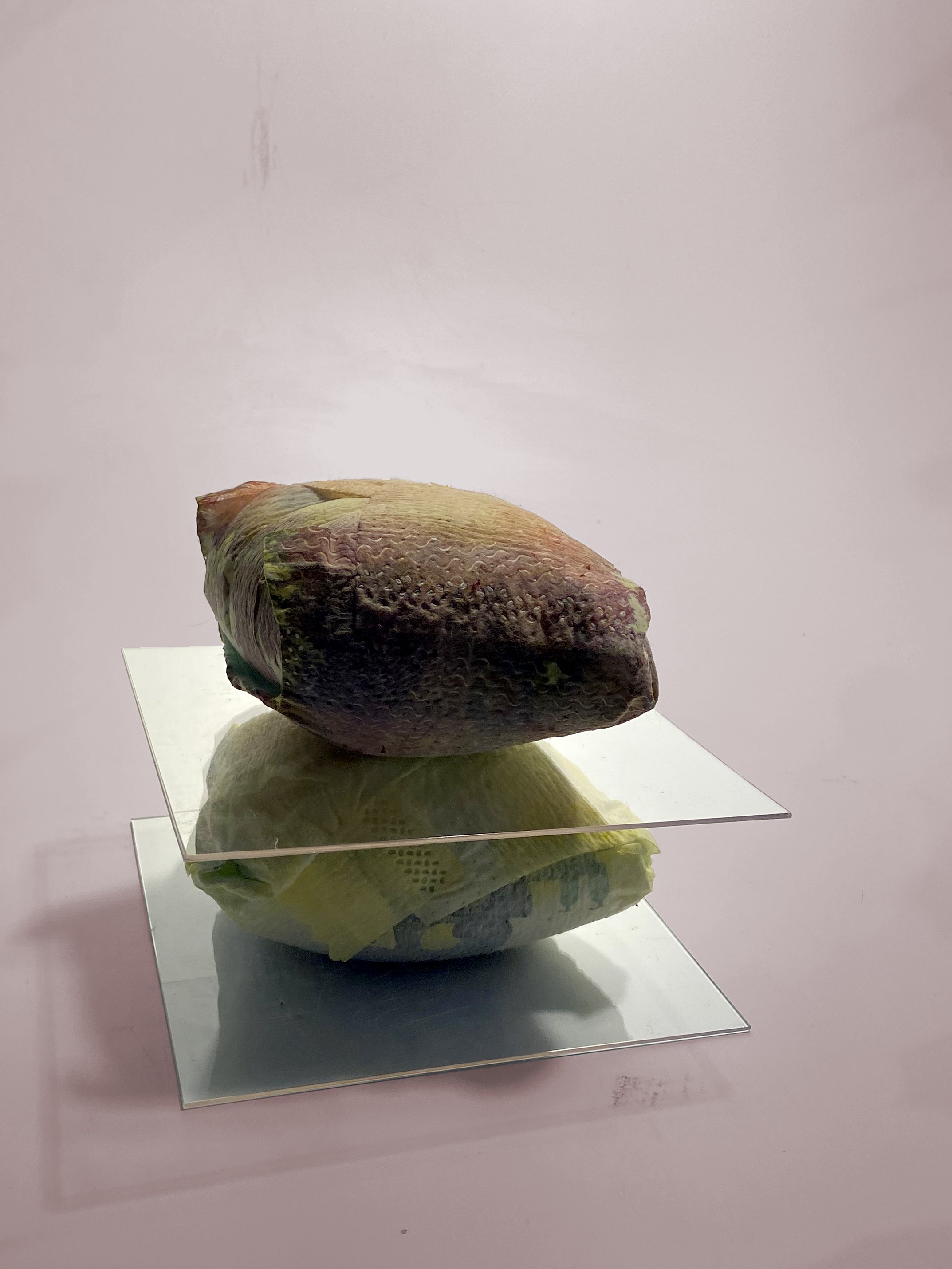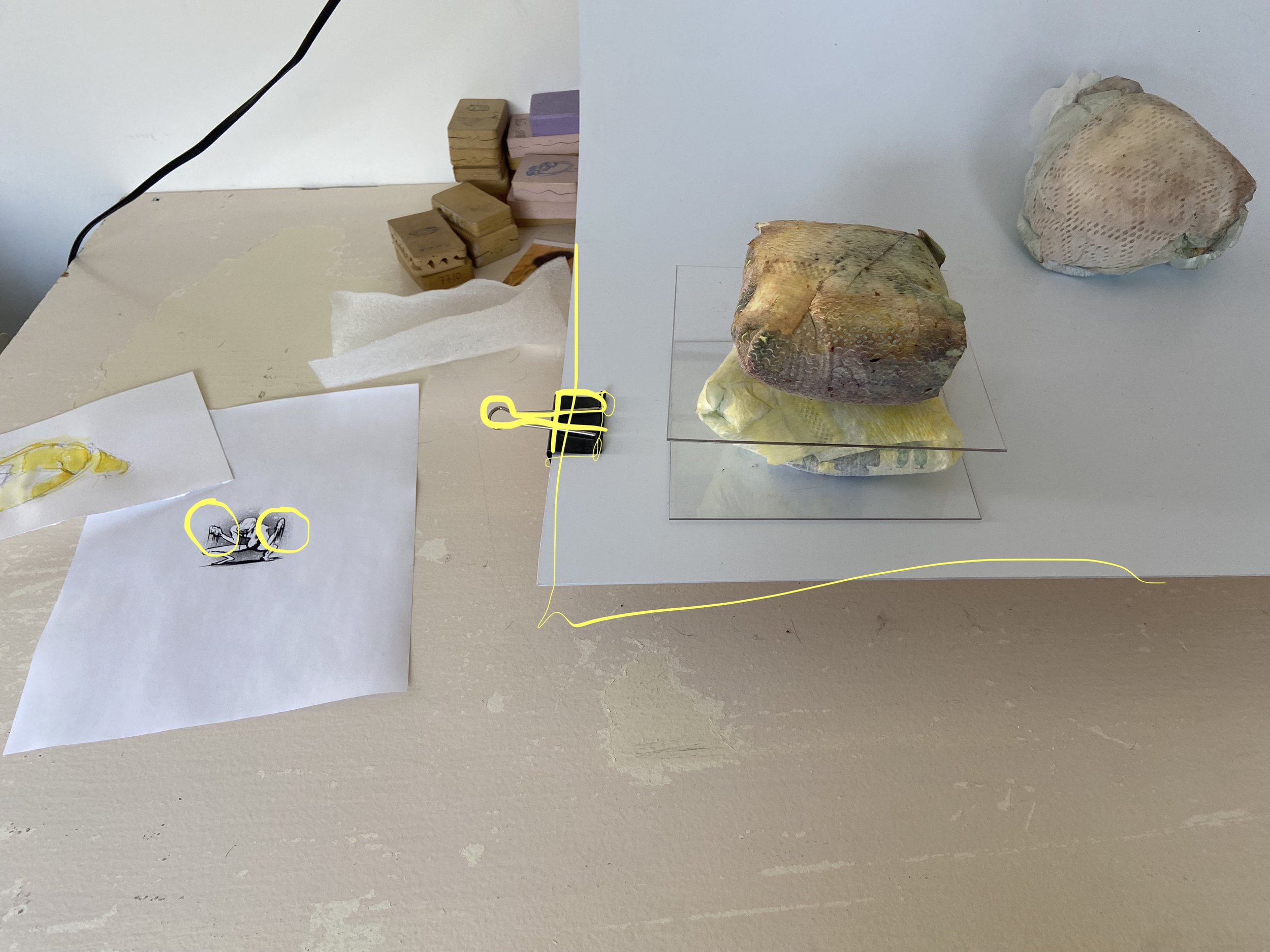Day For Night
Lauren Schaffer
Day For Night, Digital photography diptych, variable dimensions
“That bothered me at first, but it’s good to be bothered.”
Interview by C. VanWinkle
April 19, 2023
I guess we should start at the beginning. Can you describe the prompt you responded to?
It looked like a digital drawing of a humanoid figure crouched in a squatting position. It’s not too concerned with anatomical accuracy. The hands and the head share the same abstraction, so that the hands become these club forms. There's a chance that this is not human or is a pre-human kind of form. And then there are these digital slashes, so the hands are dripping, the face is dripping with these sharp, vertical gestures. Behind it is a faux-sprayed spackling of gray. The background gives this somewhat celestial feeling, maybe it's a gray sky with white spots. That could be celestial or still look very much like paint.
And actually when I printed it, it turned out to be a very small file. That isn’t obvious on a screen, but I found it funny when I printed it. It was this tiny little image.
What did it mean to you?
I couldn't help but feel like I was looking with the lens of what interests me or what I could do with it. What struck me right away was the clubbed hands. The face is a bit grotesque or not visible or erased, and shares a similar quality, but the clubbed hands were the most interesting component of the image.
So how did you get started on your piece?
Well, it wasn't exactly a start, but it was like an entry into something I was already midstream on. The shape of the clubbed hands reminded me of this shape that I'm working with, so I saw that connection. Also these hands, which we would assume to be digit-ended, articulated hands, look like they're possibly fists. Or more like they’re being bundled or something.
Being a sculptor, I’ve done these much smaller pieces, playing with a bit of, let’s say, human detritus and relating it to my own current situation in this family structure that's coming apart. These pieces also tie into my interest in casting and mold-making, parsed through this more social object, body humors and support structures for those fluids. These objects have questionable value. They’re manufactured and then they're treated or imbued with what I'm going to call “humanity.” [Cody laughs] I don’t mind saying what it is. It’s these overly saturated diapers.
When I look closely, the texture of it reads as diaper, which I could see more clearly in your process images. But it still isn’t clear what exactly is inside.
Right. The interesting thing about them is that they're not just empty vessels. They’re filters that get bloated. Diapers have all these modular cellular structures inside that individually get inflated and consumed, and then we wrap them up in this bundle. It's an interesting structure that way. It isn't just filled with something else, it’s filled with itself. I haven't yet looked into the engineering of diapers, but I'm curious about it to further this, what with my interest in mold-making.
Yes, of course you'd want to know: Is that blood? Is that human waste? It has to be a liquid of a certain viscosity. You know, you can't pour honey in it. They're stained with ink. One of them looks more like tie-dye, which I think is funny. That bothered me at first, but it's good to be bothered.
I was eating a terrible blood orange that I spent too much money on. It was dry, but the stain was really quite amazing. And because it was a blood orange, well, there's another reference to a bodily fluid. So I stained it with the blood orange and now after a few weeks, it's starting to mold. There is all this organic material developing within and around it. It’s bypassing the body, the food just going right onto this form. They have that industrial printing, so they could be napkins or even a tablecloth. I like that ambiguity about it.
It's ambiguous, yes, but all of those things still lead to something very human, involving eating and bodily processes. That vibe is there.
Diapers are, you know, this thin when you buy them, and then they expand to whatever volume. So somebody was measuring the volume they take up when they’re filled. I'm not sure where the water goes as they dry. In some ways I can tell which ones are still heavy with water and which ones are dry. I'm trying to understand that process technically because it would help me to go further with it.
I shot them individually, but then I realized that in advertisements they stack them, so I stacked mine. I often work with fabricated things that I have around the studio, and these little pieces of Plexi became part of a structure to separate them. It also separated them when they were molding. They became this architectural tower, which somewhat compromises their stability as a stack.
I like it as this diptych now. It looks like it's in a fridge or in a scientific experiment. It's also that artificial day for night, which I've been playing with in videos. I just thought, “I'm going to put everything I'm thinking about into this process,” which was fun. I work that way anyway, but this project was all the more liberating in that way.
I thought, “Let me see what it looks like shot as day-for-night with that terrible blue filter.” And I quite like it. It's a more of an obscuring of that image. It sets it in time. Maybe it refers back to the nighttime, the letting go of yourself or your fluids or something.
It reminded me of that trope, especially in old movies, how they show the passage of time. “Now here's that same house, but it's nighttime.”
Yeah, in a very ham-fisted way, which is literally, what the image is! I hadn’t thought about that: “ham-fisted.” [both laugh]
That's so cute! How do you like working from a prompt?
Most of my work tends to have these cross-mutations. In fact, I teach, so a lot of my work comes from getting ideas or responding to things that happen in the classroom. I've done demos, and then it becomes me pushing certain techniques or strategies further. And I'll bring in a lot of different mediums, because I do video work as well as graphic work. I like that this project is open and it feels like you could do that.
It was good for me to be prompted. I think it sometimes allows you to not be so precious about your own process. I'd done this once before. Here in Toronto, Midi Onodera did this video piece during Covid called EXC-19. A written prompt got passed anonymously to an artist to shoot, and then it got passed to someone to do a video edit, and then to someone to do a sound edit, and that was the piece. I ended up doing some sound components for it, and so I got it at the very end of all this stuff having happened. So I had done something similar before this. It's great to be pulled outside of your comfort zone. I certainly am new to this Bait/Switch community. I have no idea who this person is or where this work sits, and I find that freeing.
Fantastic! We deliberately keep our participants in the dark about where their prompt comes from, so they can make up their own context. And the contributors that wind up in an issue together really are just whoever we happened to cobble together who had the opportunity to play. There’s no reason or rhyme there, except that we try to mix up the mediums.
Yeah. Obviously, in life, things get tailored. By whatever.
Now that you’re on this side of it, what is your advice to another new person approaching this project?
When I showed it to another artist friend of mine, she said, “Good on you for going wherever you want to go with it!” So go wherever you want to go with it. And it doesn’t have to be this completely new endeavor for yourself. I was busy and I’d been wanting to do this, so there was a certain pressure, but it’s interesting to find a way to wedge something into what you’re already doing. Anyone would have to think about how new they’re going to be with this.
Enjoy the freedom of it and try not to be too precious about your own process.
I think that is some fine advice.
Call Number: C97VA | C99VA.scDa
Lauren Schaffer is an interdisciplinary artist who lives in Tkaronto, with roots in Tiohti:áke/Montreal. Through disruption of materials, her work considers the many overlaps between human and non-human, between ‘making and unlearning’. Closely observed location and sound circulate within the work, alluding to multiple scales of geography and time.







